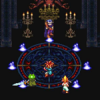Hi there,
I was hoping to simply get some direction.I want independent images to have an effect applied to them, where a y value parameter (which will increase/decrease) determines where the effect should be applied to the image. For example:
- Let's say the example image has a height of 100 pixels
- We'll start the y value at 0
Because the y value is at 0 the effect should be applied along the first row of pixels in the image (row 0). The game will update the y value, thus moving the effect up/down the image (like a scan animation, I suppose).
Now.. the effect I'm looking to do seems simple. I just want to replace a single color, a range of colors,or all the colors of the row, specified by y, with another single color. I can figure this part out.
The main problem for me, is figuring out how to apply and updating value, like y, to the effect on a single image... among many images. If anyone could point me in a good direction, I'd be grateful. It's also probably worth mentioning that i'm using XNA 4.0, and this game is using 2D spritebatch. Thanks for reading.
Nokame





